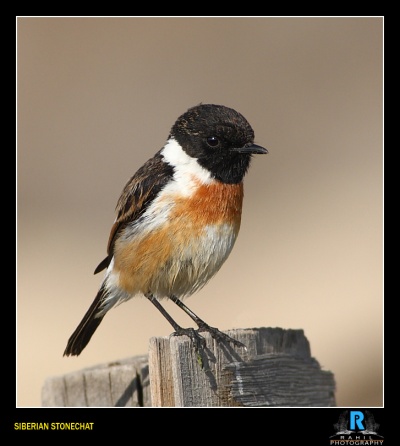- Saxicola maurus
Saxicola maura
Identification
12·5 cm (5 in)
Male
- Black head
- Distinctive white collar
- Black back
- White rump
- Black tail
- Black wings with a large white patch on the top side of the inner wing
- Dark orange-red upper breast
- White or pale orange lower breast and belly
Female
- Brown above and on head
- Indistinct pale eyebrow line
- Chestnut-buff underparts
Distribution
Found in Russia and Siberia, Turkey, the Caucasus, the Himalayas, and China. Most populations migrate south in winter.
Vagrants recorded in Europe and Alaska.
Common in parts of its range.
Taxonomy
Formerly included in Common Stonechat. Amur Stonechat was recently split from this species.
Subspecies

Photo © by Alok Tewari
Sat Tal Forest, Alt. 5500 ft., Uttarakhand Himalayas, India, April-2015
Five subspecies recognized[1]:
- S. m. hemprichii: Steppes of lower Volga and mouth of Ural River to eastern Caucasus
- S. m. variegatus from the eastern Turkey, southern Caucasus to Iran
- S. m. maurus from eastern Finland east to European Russia and central Asia; migratory to Iran, Iraq and India
- S. m. indicus in northwest and central Himalayas, migrating to lowland India
- S. m. przewalskii in Tibet, central China and northern Myanmar
Habitat
Open rough scrubland and rough grassland with scattered shrubs.
On migration may be found in drier areas.
Behaviour
Most often seen in pairs perched up on a stick or shrub. It flies down onto the ground, returning to the same perch. Often flicks its wings.
Diet
Eats almost entirely small or medium-sized insects and their larvae. Takes occasionally small vertebrates, seeds and fruit.
Hunts from low perches, flying down to take prey and very often returning to the same perch. Also sometimes sallies for aerial prey.
Breeding
Breeding season from end of April to late July, starts later (mid-May) in northern Siberia, April to August in the Himalayas.
The nest is well hidden inside a clump of vegetation and consists of an untidy bowl of grass and rootlets. It is lined neatly with rootlets and animal hairs.
Movements
A migratory species.
Vocalisation
Recording by Alok Tewari
Sat Tal Forest, Alt. 5500 ft., Uttarakhand Himalayas, India
Song given by a male in full breeding plumage.
References
- Clements, J. F., T. S. Schulenberg, M. J. Iliff, S. M. Billerman, T. A. Fredericks, J. A. Gerbracht, D. Lepage, B. L. Sullivan, and C. L. Wood. 2021. The eBird/Clements checklist of Birds of the World: v2021. Downloaded from https://www.birds.cornell.edu/clementschecklist/download/
- Del Hoyo, J, A Elliot, and D Christie, eds. 2005. Handbook of the Birds of the World. Volume 10: Cuckoo-Shrikes to Thrushes. Barcelona: Lynx Edicions. ISBN 978-8487334726
- BirdLife International
Recommended Citation
- BirdForum Opus contributors. (2024) Siberian Stonechat. In: BirdForum, the forum for wild birds and birding. Retrieved 29 April 2024 from https://www.birdforum.net/opus/Siberian_Stonechat
External Links
GSearch checked for 2020 platform.1






